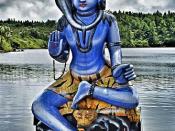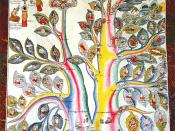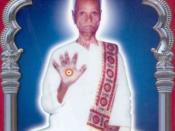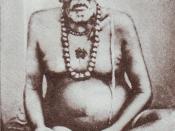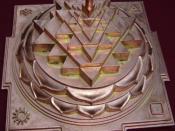Tantra plays an important role in Hinduism as a method of honoring the feminine divine. This neglected branch of Indian spiritual practices dates back to the 5th-9th century AD. Although the history or origins of Tantra are difficult to trace, ÃÂthey offer mythical explanations for their origins, often setting themselves as the given word of Siva of the goddess Devi.ÃÂ The actual word Tantra can have two different meanings: the sacred literature which appeared from the 5th century onward and focused on the cults of all of the earlier deities and the second meaning restricts the texts to the worship of Shakti. Tantric literature somewhat disregards the caste system because in these texts, women are held in high regard. As it refers to Hinduism, Tantra ties closely to Vedic tradition, or rather the rejection of the orthodox beliefs.
The Hindu Tantras were written in the medieval period, sometime after the Puranas and was set up as a dialogue between Shiva and his consort.
Most of the dialogue was Shiva explaining to Parvati about the philosophy and myths underlying the Tantric ritual. This ritual involves reversals of normal Hindu social practices and reversals of normal physiological processes. ÃÂIt also reverses the orthodox Hindu ÃÂfive products of the cow,ÃÂ or panchagavya (milk, butter, curds, urine, and feces) used for purification; in Tantra, these become the ÃÂfive m'sÃÂ: maithuna (ÃÂintercourseÃÂ), matsya (ÃÂfishÃÂ), mansa (ÃÂfleshÃÂ), mudra (ÃÂparched grainÃÂ), and mada (ÃÂwineÃÂ).ÃÂ Fisher explains in Living Religions that, ÃÂSacred texts called Tantras instruct worshippers how to honor the feminine divine.ÃÂ The women are highly venerated in Hinduism and so a lot of their rituals involve worshipping a feminine divine of some sort.
In Hindu Tantra, two distinct branches evolved as a result of the union between Shiva and Shakti. One branch was known as the right-hand path (Dakshina Marga) and the other is called the left-hand path (Vama Marga). The right-hand path is considered to be the conservative approach to worshipping, by chanting and having a devotional attitude. The left-hand path involves allowing sexual union as a means of obtaining Enlightenment. The intent of "Right-Hand Path" belief systems is to attain proximity to divinity, or integration with divinity and the intent of the Left-Hand Path belief systems is to become divinities in their own right.
Tantra is often preferred over other traditions because ÃÂbecause it takes the whole person, and his/her worldly desires into account.ÃÂ The other traditions teach that you must learn to get rid of your desires in order to achieve enlightenment, but in most cases this results in a conflict with the self. People are definitely drawn to the spiritual beliefs, but they also feel the need to fulfill their desires. Without Tantra, people will begin to feel guilty or wrong for having such thoughts and feelings about their desires. Tantra offers an alternative to the traditional approach to enlightenment.
Some of the basic Tantric practices in Hinduism are Mantra and Yantra, identification with the deities, concentration on the body, and taboo-breaking. Mantra and Yantra is a practice that focuses on the mind, usually through a specific Hindu god. Identification with the deities deals with embracing the Hindu gods and using them as objects of meditation. Concentration on the body means that different parts of the body are meditated over and may also be associated with planets, elements, or powers. The act of breaking taboos is associated with the left-hand path because it is not very beneficial to the persons participating in it. Tantra and Tantric rituals states that, ÃÂTantras prescribe a strict regimen of penance, meditation, sensory control, cleansing the self of negative thoughts, and seeking truth and justice before an individual can hope to transcend from his or her natural state.ÃÂ Followers of the Tantras believe that through those elements, they will be able to reach a state of enlightenment. Another practice or form of reaching enlightenment that is important to Tantra is yoga. Yoga ÃÂawakens the ability to reach the divine in the practitioner.ÃÂSome of the modern forms of Tantra deal with sexuality, deified sexuality, etc. Each form is different based on the time period and the environment. In some parts of India, Tantra remains or is practiced in its original or ÃÂtrueÃÂ form. The form of Hindu Tantra popularly practiced in America is said by Hindu Tantra traditionalists, ÃÂto represent a mutilated and extremely narrow-minded, sensationalist approach encompassing only a misguided thinking about sacred sexuality, with little reference to its true practice.ÃÂ Traditional Tantrists say their practice involves much more than that. It requires self-analysis and the conquest of material ignorance, often through the body, but always through a pure outlook of the mind. Real Tantra is about transforming one's sexual energy into spiritual progress, not senseless acts of sexual intercourse.
In Hinduism, there are many religious foundations and theistic paths. Tantra is just one of the many paths to enlightenment through devotion and intense worshipping. It is also important that the women are highly venerated in Hindu practice. The Tantras are simply instructions on how to worship the feminine divine. Tantra is relevant in the study of traditional Hinduism because it breaks away from the original way of reaching enlightenment. Tantra shows that not all rituals are the same or deal with getting rid of oneÃÂs desires. When practicing Tantra, you are able to meditate and do all of the same things as traditional rituals, but instead you are satisfying your desires as well. Tantra, tantricism, etc. are important aspects in studying Hindu and should not be disregarded in the study of Indian rituals, but more importantly Hindu rituals.
Works Cited/ReferencedEpand, Victor. "A Brief History of Tantra." Mind-Body-Spirit. 2008. EzineArticles.com. 1 Oct 2008 .
Fisher, Mary Pat. Living Religions. 7th. Upper Saddle River, NJ: Pearson Education, Inc., 2008.
"Hinduism." Microsoftî Encartaî Online Encyclopedia 2008. 1997. Microsoft Corporation. 1 Oct 2008 .
Jayaram, V. "Tantra and Tantric Rituals." Hindu Website. 2000-2007. Hinduwebsite.com. 1 Oct 2008 .
Sarbatoare, Octavian. "Buddhist and Hindu Tantras." 2001. Geocities.com. 1 Oct 2008 .
"What is Tantra?" Hinduism. 2008. About.com. 1 Oct 2008 .
